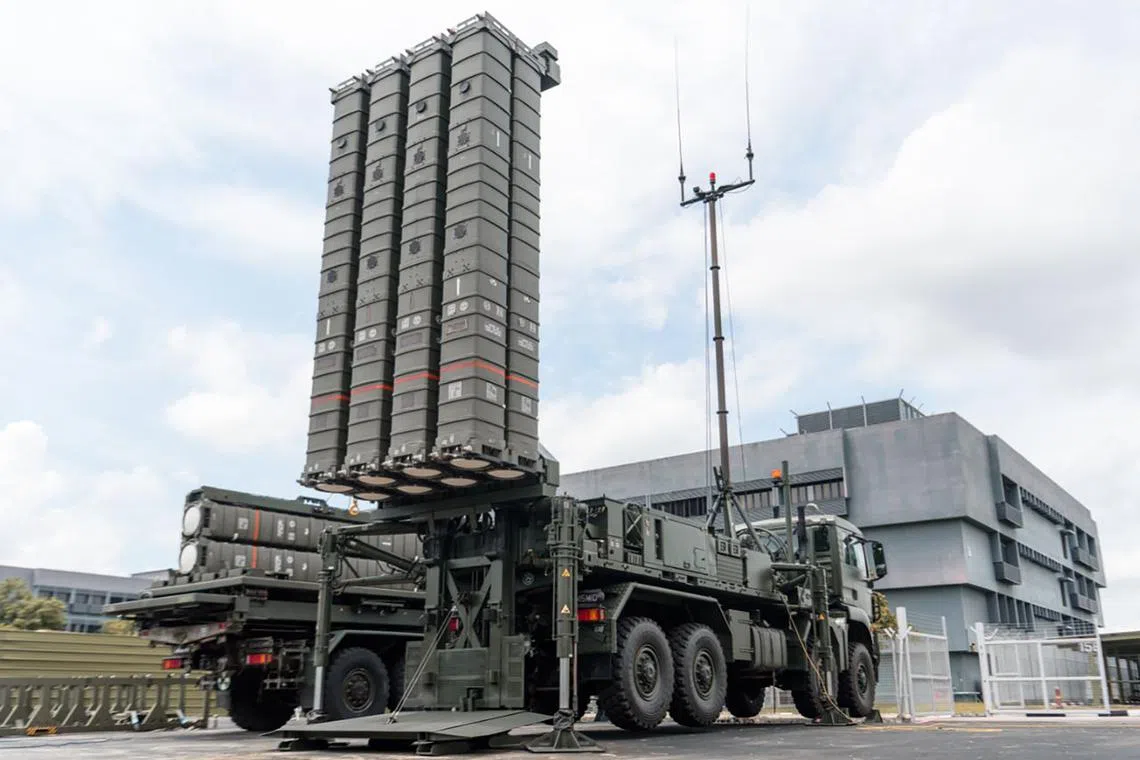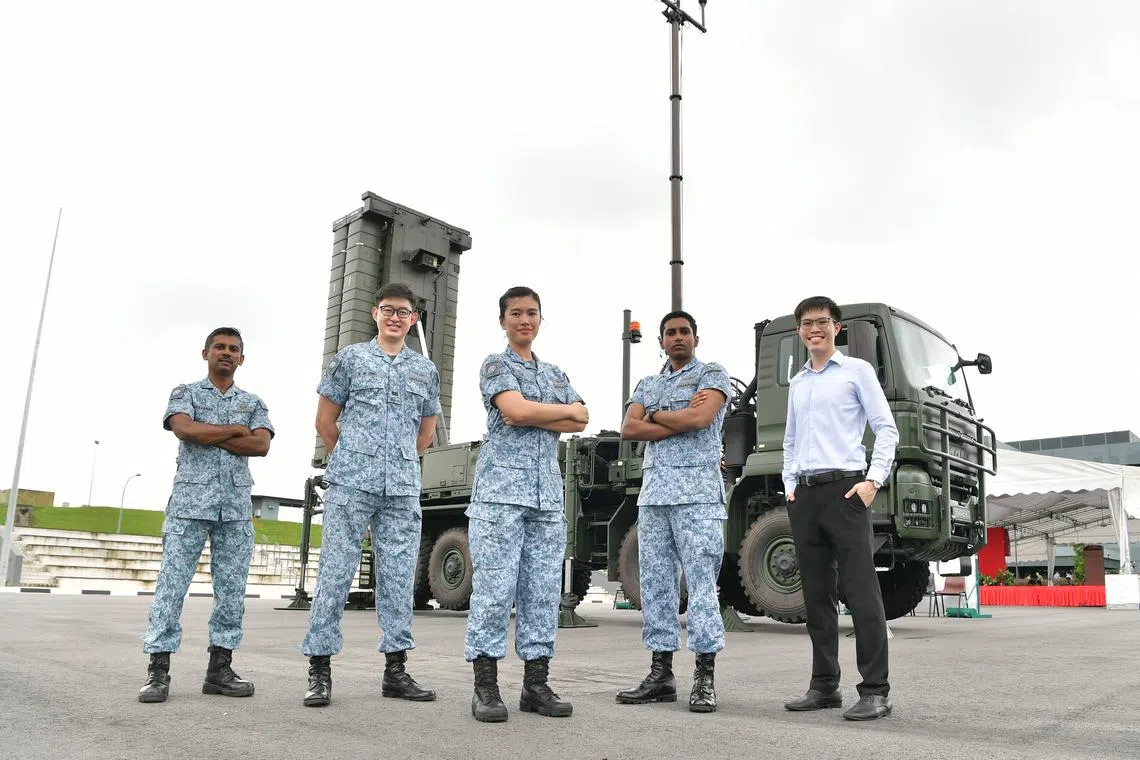Aster 30, the ‘last puzzle piece’ of RSAF’s Island Air Defence system, now fully operational
Sign up now: Get ST's newsletters delivered to your inbox

Designed with anti-aircraft and anti-missile capabilities, the Aster 30 can counter a wide spectrum of air threats.
PHOTO: MINDEF
Follow topic:
SINGAPORE - The Aster 30 Missile System – the “last puzzle piece” of the Republic of Singapore Air Force’s (RSAF) nationwide air defence system that provides a security blanket over the country – is now fully operational.
While the Aster 30 has been activated for round-the-clock air defence operations since August 2020, reaching this milestone status means that RSAF personnel have been proficiently trained to operate the ground-based system fully.
At the Full Operational Capability Declaration Ceremony at Lim Chu Kang Camp II on Nov 29, the commanding officer of the 163 Squadron, Major Graci Wong, said: “We can respond faster, shoot farther with greater precision against a wide range of (air) threats, and provide Singapore with extended air defence coverage.”
Beyond its individual capabilities, the Aster 30 is the final component that completes what the Island Air Defence (IAD) system was designed to do, said Maj Wong.
Conceptualised around 2006, the multi-layered IAD system integrates advanced sensors, weapon systems, command and control elements, data analytics and artificial intelligence.
Together with the smart Combat Management System, the air defence system jointly developed by the RSAF and the Defence Science and Technology Agency (DSTA) provides a real-time picture of the air situation by organising and combining data from multiple sources.
The Aster 30, which is part of the IAD’s weapons system, replaced the I-Hawk system that was used for more than 30 years. Singapore first took delivery of the French-made Aster 30 in 2018.
Designed with anti-aircraft and anti-missile capabilities, the Aster 30 can counter a wide spectrum of air threats, from fighters and helicopters to unmanned aerial vehicles and precision-guided munitions.
It can also intercept air threats at a farther distance than the I-Hawk, with an extended engagement envelope of up to 70km against fighter aircraft.
It has the ability to engage multiple air threats simultaneously, and neutralise them at a longer range and with greater precision.
Compared with its predecessor, the Aster 30 also needs less manpower because of greater automation. Just six people are required, compared with the I-Hawk’s requirement of 11.
While the Aster 30 presents a more efficient and easier way of protecting the skies, Maj Wong said there are new challenges to overcome.
She said the air defence specialists, in particular, faced a steep learning curve when it came to familiarising themselves with the new system. They also had to learn about diagnostics and understand how the Aster 30 connects to the wider system.

(From left) Air Defence Systems Specialist 2WO Saravanan Ellangovan, Team Commander Lieutenant (NS) Gaius Ong Kiat Woon, Commanding Officer Major Graci Wong and Air Warfare Officer Captain Roy Francis with DSTA senior engineer Joel Toh Hang Hwa.
PHOTO: MINDEF
Besides going through training and conversion courses, the RSAF personnel tapped the expertise of engineers and the DSTA to “level up (their) knowledge”, said Maj Wong.
She added that adapting to the Aster 30 is a continuous learning process, and the team is still gleaning “valuable lessons”.
“Even up to this day, we’re still learning things about the system, just because there (are) so many components to it.”
One way the Aster 30 in Singapore is crafted differently from its original configuration is that the DSTA designed and built a tactical command post that connects the missile system to the IAD system, which has a range of advanced early warning sensors. These include the Multi-Mission Radar and the Shikra radar, a three-dimensional mobile radar.
Maj Wong said that the system can tap sensors that are within the IAD network, allowing the RSAF to respond much faster as the systems reduce the need for cognitive work.
Air defence systems specialist Saravanan Ellangovan was sentimental about switching over to the Aster 30. When he started his career with the RSAF, he learnt how to operate the I-Hawk system and used it for more than 15 years.
When the Aster 30 replaced the I-Hawk system, the Second Warrant Officer (2WO) was part of the pioneer batch of RSAF personnel who did a three-week training course overseas to learn how to operate the new system.
“I learnt that the enhanced capability (of the Aster 30) is far better than the I-Hawk. It will definitely be better in safeguarding Singapore,” said 2WO Saravanan, who is also the squadron’s flight chief who trains other personnel to use the Aster 30.
Senior Minister of State for Defence Heng Chee How, who officiated at the ceremony, said that ongoing conflicts elsewhere such as the Russia-Ukraine war and the Israel-Hamas conflict show it is imperative that Singapore takes its defence and air defence ever more seriously.
He said: “As the range of threats continue to evolve, it is important that the RSAF inducts more capable systems to match.”


